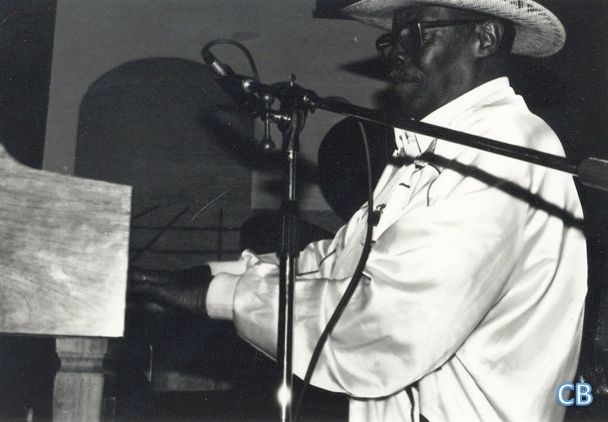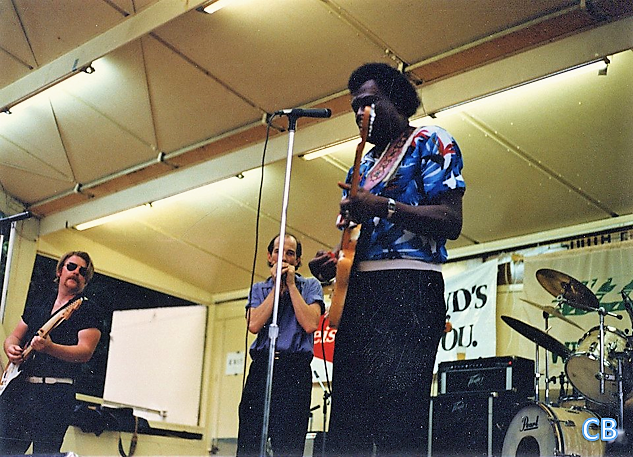Recommended Blues Recording
The Legendary Blues Band – Storied Backing Blues Band Strikes Out On Its Own
The Legendary Blues Band – Red Hot ‘N’ Blue – Rounder Records CD 2035
Most of us spend a lifetime in the work-a-day world biding our time until retirement is an option. Some people do find a career that aligns with their ultimate aspirations and, as they say, “they never truly work a day in their lives.” But the vast majority of individuals spend their working years grinding out a living, year after year, until enough time passes and withdrawal from the workforce at a ripe age finally becomes an option.
So, imagine working in the band of the bluesman who has been rightfully credited with being the architect of not only post-war blues, but of rock-n-roll, and it’s not a stretch to say, the most of modern music. But further, envision being in that rarified position and making the conscious decision to leave that opportunity behind. To quit outright. For the members of Muddy Waters’ band in 1980, that is exactly what they decided to do.
In a mass dispute over money (isn’t it always about money), blues drummer extraordinaire Willie “Big Eyes” Smith, blues guitar great Bob Margolin, dependable blues guitarist Luther “Guitar Junior” Johnson, blues piano titan Pinetop Perkins, blues harmonica ace Jerry Portnoy, and fine blues bassist Calvin “Fuzz” Jones, resigned as a collective group from Muddy Waters’ band. This was a full three years before Waters’ death, and he was still plying his blues trade to appreciative audiences everywhere.
This mass resignation was not one by marginally talented blues musicians. A glimpse once again at the roster of men who willingly chose to leave Waters highlights a renowned group of blues musicians still at the heights of their powers, individual and collectively. Rather than let that talent and inter-band traction be left behind, Perkins, Portnoy, Smith, and Jones decided, to all our benefit, to form a new blues aggregation, The Legendary Blues Band. This name was a direct borrowing of a nickname that Waters used when he would introduce the band.
“Legendary” is a word of tall order. It symbolizes that which is illustrious. And considering the wealth of seasoned blues talent brought to bear in what could be arguably considered a “blues super-group”, the “Legendary” label was most certainly appropriate. The only two members who left Waters’ group who did not follow the rest to this new blues band were Margolin, as he decided to start his own blues band. And, Johnson stepped out on his own, as well. Initially, the famed Louis Myers handled the guitar chores in The Legendary Blues Band.
The Legendary Blues Band enjoyed a storied run from 1980 until 1993, recording seven albums for the Wild Dog, Rounder, and Ichiban labels.
Red Hot ‘N’ Blue was the second outing by The Legendary Blues Band, and on this collection, Peter Ward was handling the group’s guitar duties. But, there were a number of special contributors to this album who added decidedly to the proceedings. Duke Robillard guested on guitar on all cuts, with a trio of fine horn men providing support; Greg Piccolo, Rich Lataille, and Doug James.
This 1983 release for Rounder finds Jones delivering stellar solo vocals on three cuts, and sharing vocal duty on one selection with Jerry Portnoy. Perkins contributes seasoned vocal work on four songs, while Portnoy, in addition to his work with Jones, supplies superb vocals on one offering. All band members sing confidentially and with inspired blues form, which is indicative of the unique personal styles they honed over their many individual years performing the blues. There is depth, soul, and true feeling with each vocal endeavor.
Portnoy’s harmonica exertions are on-point, never obtrusive, always tasteful, and his solo effort, “Blues For Big Nate”, is a study in classic full-toned blues harmonica.
Perkins’ blues piano is both tender and ribald when required, and in the most perfect of ways, classic. Both his sparseness and rollicking energies provide the ideal moods.
Listen closely to the Jones’ bass work. It rumbles and rolls forward with an idyllic combination of low-end foundational attributes and that “never-in-your face” manner that a grand bass line should be.
Smith deservedly earned his glowing reputation as a human metronome throughout his long blues career, ably affording timekeeping of the highest order, and during this set, such is the case. His abilities almost make taking the percussion duties for granted. That would be a mistake.
The combination of Ward’s and Robillard’s blues guitar work accentuates what graceful and tasteful approaches can achieve, and the sax work of Piccolo, Lataille, and James swings and bobs, no better than on “Do The Get Down”.
I remember The Legendary Blues Band rolling through Mishawaka, IN’s Center Street Blues Café one evening in the late 1980s, with Madison Slim on harmonica, and Louis Myers affording blues guitar undertakings. It was a textbook reading of how blues done with touch, wisdom, and respect could yield magnificent musical results. While The Legendary Blues Band adapted through the years, bringing bluesmen such as the aforementioned Madison Slim, plus keen blues guitarist Billy Flynn, and blues guitarist Nick Moss, into the group, uniformly, their communal performing and recording qualities never wavered.
This is a blues compendium that belongs in any serious collection. Highly-recommended!





